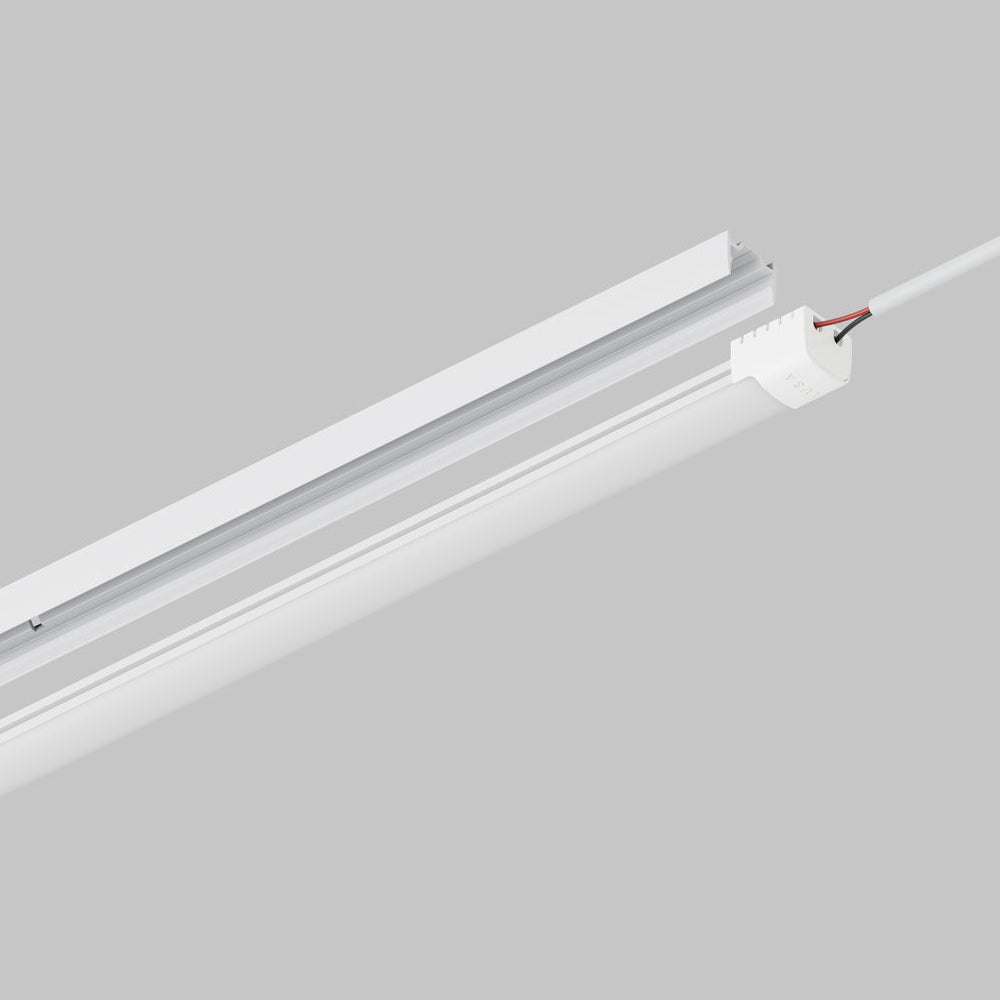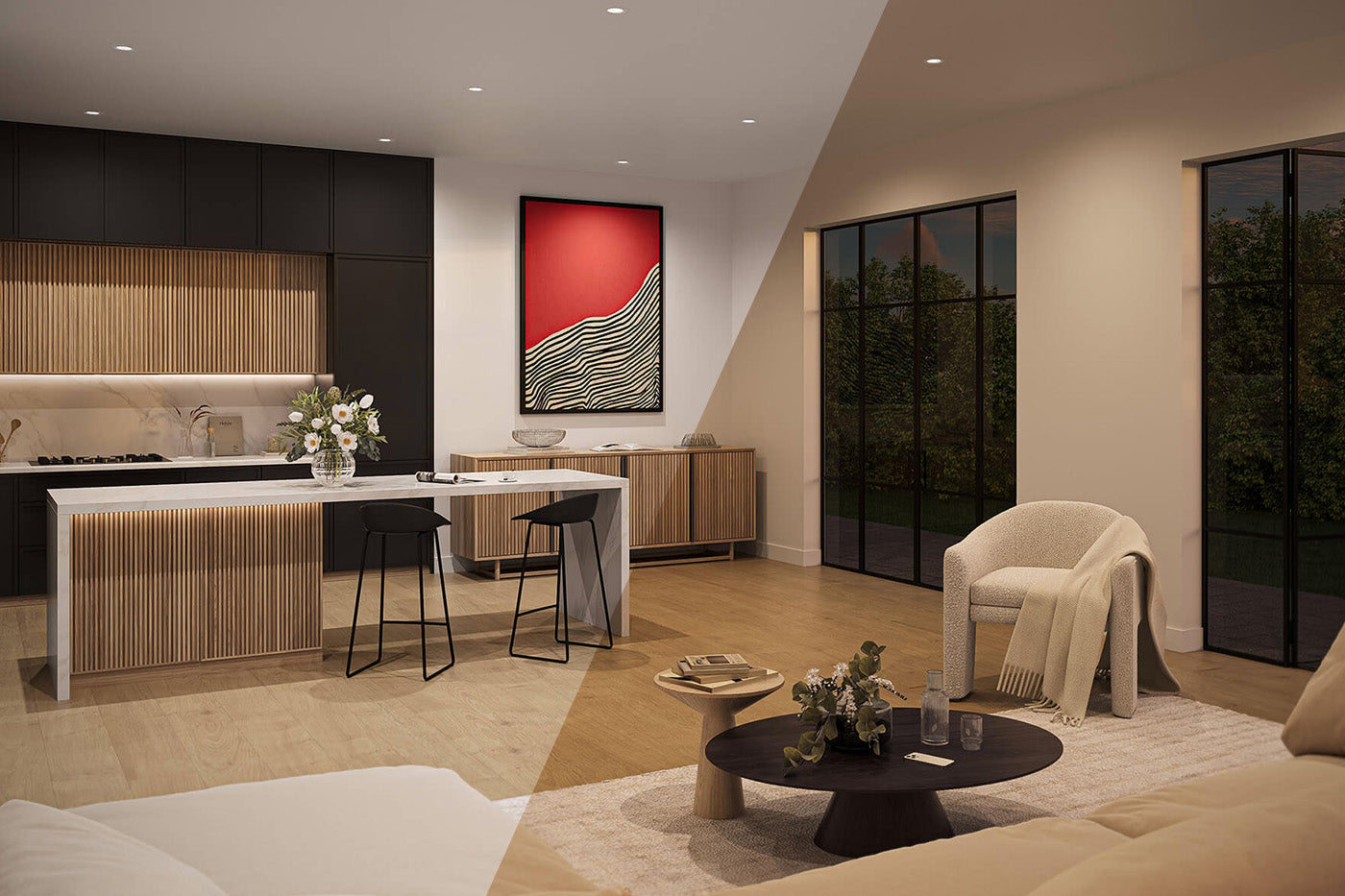Lighting plays an important role in shaping the ambiance and functionality of any space. With the mission to bring premium designer lighting within reach of every homeowner, LUSA offers a range of high-end lighting solutions that are aesthetically pleasing and easy to install.
Whether you're a seasoned DIYer or a professional contractor, installing recessed lighting can transform living spaces with elegance and modernity.
What Are the Benefits of Recessed Lighting?
Recessed lighting offers many benefits, making it a popular choice for homeowners seeking to enhance their interiors.
Here are some key advantages of incorporating recessed lighting into your home:
- Versatility: Recessed lighting fixtures are versatile and adaptable, fitting seamlessly into various design styles and room layouts. They provide a sleek, unobtrusive lighting solution that doesn't clutter the visual space.
- Space-saving: Unlike traditional lighting fixtures, recessed lights are installed flush with the ceiling, saving valuable space and creating a clean, streamlined look. This makes them ideal even in rooms with low ceilings or limited space.
- Modern Appeal: Recessed lighting imparts a contemporary and sophisticated appeal to any room. These fixtures' sleek and minimalist design adds a touch of elegance and modernity to your home decor.
- Energy Efficiency: Choosing LED recessed lighting takes energy efficiency into account. By using LED technology, these lights consume less power while providing bright and ambient illumination, helping you save on energy costs in the long run.
- Enhanced Ambiance: Recessed lighting allows for precise control over the illumination in your space. Whether highlighting specific architectural features, creating task lighting zones, or setting the mood with dimmable options, recessed lights offer versatility in creating the desired ambiance.
By exploring the world of recessed lighting, you can discover new possibilities for transforming your home into a well-lit, stylish, and inviting sanctuary.
What Are the Recessed Lighting Components?
When beginning a recessed lighting installation project, it’s important to familiarize yourself with the essential components that make up this lighting.
Here's a breakdown of the key elements involved:
- Housing: The housing serves as the foundation of the recessed lighting, shielding and holding the electrical components securely within the ceiling. It comes in various types, including new construction and remodeling, each designed for specific installation requirements. IC-rated housings have been tested and approved for direct contact with insulation. This is important because insulation can trap heat, and if a light fixture is not rated for direct contact, it could overheat and become a fire hazard.
- Trim: The trim is the visible part of the recessed light that sits flush against the ceiling. It plays an important role in the light beam distribution and in the aesthetics of the lighting fixture. Trims come in different styles and finishes to provide the desired lighting effect and complement your home decor.
- Light Module: The type of module you choose for your recessed lighting will impact factors such as brightness, color temperature, and energy efficiency. LED modules are the preferred choice for their longevity, energy efficiency, and light output quality.
Understanding these components will enable you to select the right fixtures that align with your design preferences and installation needs.
What Does Planning and Preparation Look Like?
Before getting into the installation process, thorough planning and preparation are key to ensuring a successful outcome.
Here's a step-by-step guide to help you get started:
- Layout Planning: Begin by sketching a layout of where you want to install the recessed lighting. Consider the room's dimensions, furniture placement, and the desired lighting effects. Aim for even light distribution across the space.
- Spacing and Placement: Determine the spacing between the fixtures based on the room size and ceiling height. Common spacing recommendations range from four to seven feet apart for general lighting and closer spacing for task-oriented areas.
- Fixture Quantity: Calculate the number of fixtures needed based on the room size, desired light output, and the function of the space. Avoid over-illuminating or under-illuminating certain areas by strategically placing the fixtures.
- Electrical Capacity: Assess the electrical capacity of the room to ensure it can support the additional load of the recessed lighting fixtures. LED lighting does not create a significant load, but consider consulting with a professional electrician for guidance on wiring and safety requirements.
By planning and preparing for your recessed lighting installation, you set the foundation for a seamless and visually appealing lighting upgrade that enhances the ambiance and functionality of your living spaces.
What Is the Installation Process?
Now that you've planned and prepared for your recessed lighting installation, it’s time to dive into the hands-on installation process. It’s important to note that these instructions are for a finished ceiling.
Follow these step-by-step instructions to bring your vision of enhanced lighting to life:
-
Turn Off the Power: Before beginning any work, turn off the power to the area where you'll install the recessed lighting fixtures. This step ensures safety during the installation process.
-
Cut Holes in the Ceiling: Use a hole saw to cut holes in the ceiling where the fixtures will be placed. Follow the layout plan you created during the planning phase for accurate placement.
-
Securing the Housing: Secure the housing of each recessed lighting fixture into the ceiling. Follow the specific installation instructions provided by the manufacturer to ensure proper placement and alignment.
-
Wiring the Housing: Connect housing wiring to the home’s electrical source. Follow national and local electrical codes and the manufacturer's instructions for proper wiring and secure connections.
-
Installing Trims: Once the fixtures are secured, install the trims by attaching them to the housing. Trims enhance the aesthetics of the fixtures and help direct and control the light output.
-
Testing the Lights: After completing the installation, turn on the power and test each recessed lighting fixture to ensure it functions correctly. If appropriate, make any necessary adjustments to the direction and angle of the lights for optimal illumination.
How To Adjust and Make Final Touches
Fine-tuning the positioning and brightness of your recessed lighting fixtures can greatly impact the overall ambiance and functionality of the space.
Here are some tips for adjusting and adding final touches to your newly installed lighting:
- Incorporating Dimmer Switches: Consider installing dimmer switches to have greater control over the brightness and mood of the lighting. Dimmable options allow you to set the perfect ambiance for various activities and times of day.
- Direction and Angle Adjustment: If the light is adjustable, adjust the direction and angle of the recessed lights to illuminate specific areas or architectural features in the room. Experiment with different angles to achieve the desired lighting effect.
- Smart Lighting Integration: Explore smart lighting features that enable automated schedules, remote control, and integration with smart home systems. Smart lighting offers convenience and customization options to enhance your lighting experience.
By adjusting and adding final touches to your recessed lighting installation, you can customize the lighting in your home to suit your preferences and lifestyle, creating a welcoming and well-lit environment for relaxation, productivity, and everyday activities.
What To Know About Troubleshooting and Maintenance
As you enjoy the benefits of your newly installed recessed lighting fixtures, it's essential to be prepared for any potential issues and maintain the longevity of your lighting system.
Here are some pointers on troubleshooting and maintenance:
- Troubleshooting Tips: If you encounter any issues with your recessed lighting, start by checking the power supply, ensuring proper connections, and examining the compatibility of modules and dimmer switches. Consult with a professional if needed for more complex issues.
- Common Issues: Be aware of common issues such as flickering lights, inconsistent illumination, or buzzing noises. These issues can often be resolved by checking the wiring connections, or adjusting components such as dimmer switches or upgrading LED modules.
- Regular Maintenance: To keep your recessed lighting fixtures in optimal condition, perform regular maintenance checks. Clean the trims and fixtures to remove dust and debris that may affect light output.
By staying proactive with troubleshooting and maintenance, you can address minor issues promptly and prolong the lifespan of your recessed lighting system, ensuring consistent performance and functionality.
Factors To Consider When Installing LED Recessed Lighting Into An Existing Ceiling
Installing LED recessed lighting into an existing ceiling can be a rewarding project, but it comes with its own considerations.
Here are some important factors to keep in mind before beginning installation:
- Ceiling Structure: Assess the ceiling structure to determine if it can support the weight of the new fixtures. Ensure there is enough space above the ceiling to accommodate the recessed lights and wiring.
- Wiring Compatibility: Check the existing wiring to ensure the new LED recessed lighting fixtures can be connected to it. If needed, consult an electrician to install wiring for safe and efficient operation.
- Insulation and Ventilation: If insulation is present, verify the lighting fixtures are IC-rated to prevent overheating. Proper ventilation between the fixtures and insulation is important for optimal performance and longevity.
- Type of Housing: Select the appropriate type of housing for the LED recessed lights based on the ceiling structure and installation requirements. Remodel housings for existing ceilings are specially designed to be installed without the need to remove the existing ceiling.
- Dimmer Compatibility: Determine if your existing dimmer switches are compatible with LED recessed lighting. LED lights require specific dimmers to control brightness effectively and prevent flickering or buzzing.
By considering these factors before installing LED recessed lighting into an existing ceiling, you can ensure a smooth and successful installation process while enhancing the lighting and aesthetics of your space.
What Are Common Mistakes To Avoid When Installing Recessed Lighting?
When installing recessed lighting in your home, paying attention to details is essential to ensure the best results.
Here are some common mistakes to avoid to ensure a successful installation process:
- Incorrect Placement: Proper placement is one of the most essential aspects of recessed lighting. Avoid placing lights too close together or too far apart, as this can lead to uneven lighting and shadows in the room. Plan the layout carefully to achieve balanced illumination.
- Ignoring Electrical Requirements: It’s important to adhere to electrical codes and requirements when installing recessed lighting. Ensure that the wiring is done correctly and the fixtures are compatible with the electrical system in your home to prevent safety hazards.
- Choosing the Wrong Type of Trim: Selecting the right trim for your recessed lighting is essential for aesthetics and functionality. Avoid using trims that are not suitable for the housing or that do not complement the room's design.
- Overlooking Insulation Contact (IC) Ratings: If your recessed lights are in contact with insulation, make sure to choose fixtures with proper Insulation Contact (IC) ratings. Failing to do so can create a fire hazard and compromise the safety of your home.
- Improper Spacing: Incorrect spacing between recessed lights can result in either over-illumination or dark spots in the room. Follow spacing guidelines based on the room size and the fixtures' brightness to achieve optimal lighting distribution.
- Using Incorrect Module Types: Ensure you use the correct modules for your recessed lighting fixtures. Using modules with wattages that exceed the fixture's rating can cause overheating and potential damage.
- Neglecting Dimmer Compatibility: If you plan to use dimmer switches with your recessed lighting, ensure the fixtures are compatible with dimmers. Using incompatible fixtures can result in flickering lights or damage to the dimmer switch.
- Lack of Adequate Ventilation: Recessed lighting fixtures generate heat, so it’s important to provide adequate ventilation to prevent overheating. Ensure enough space between the fixtures and insulation to allow for proper airflow.
By avoiding these common mistakes and following best practices during the installation process, you can ensure that your recessed lighting system functions effectively, enhances the aesthetics of your space, and contributes to a safe and well-illuminated environment.
Elevate Your Space with LUSA's Premium Lighting Collections
Looking to add an element of sophistication and comfort to your living environment? Look no further than LUSA’s exceptional lighting collections, designed to transform your space with style and functionality.
At LUSA, we believe in bringing designer lighting into the homes of everyday individuals, and our Remodel Recessed Lighting Kit is a prime example of the innovation and quality we stand by.
Transform Your Space with Ease and Elegance
Our Remodel Recessed Lighting Kit offers a seamless upgrade to your lighting without the hassle of ceiling damage, providing a hassle-free installation process.
With just two tension clips, you can effortlessly enhance your space with premium trim styles and colors that instantly elevate any room. Whether you are remodeling your living room, kitchen, bathroom, office, hallway, or bedroom, our lighting solutions are designed to deliver both design and efficiency.
Unmatched Features for Unparalleled Comfort
With features like warm dimming technology, our lighting kit allows you to set the perfect ambiance for any occasion, ensuring a comfortable and inviting atmosphere. Suitable for wet locations, our products are versatile and can be installed in various indoor and outdoor settings, including patios and balconies with closed ceilings.
The high Color Rendering Index (CRI) of 90+ ensures true color representation, while the variable Lumens provides flexibility in brightness levels to suit your needs.
Quality Assurance and Longevity
At LUSA, we prioritize quality and reliability in all our products. Our Remodel Recessed Lighting Kit is backed by a generous five-year, 50,000-hour warranty, giving you peace of mind and confidence in your purchase. With certifications from Energy Star, UL, Title 24 JA8, and Declare Listed, you can trust in our lighting solutions' superior performance and durability.
Explore LUSA’s Lighting Collections Today
Experience the difference that LUSA’s lighting collections can make in your home. From enhancing your living space to improving your overall well-being, our products are designed to exceed your expectations. Discover the perfect balance of design, comfort, and efficiency with LUSA’s premium lighting solutions.
Transform your space, enhance your lifestyle, and illuminate your life with LUSA’s exceptional lighting collections. Explore our website today at lusalighting.com and discover how lighting can enhance your daily life.
Sources:
Calculating General Lighting Loads for Residential Dwellings | IAEI Magazine
What Is the Importance of IC Rating of Recessed Lights? | LampHQ
7 Key Steps In Lighting Design Process | Electrical Engineering Portal
How Many Lights Can Be on a 20 Amp Circuit Breaker? | Galvin Power



